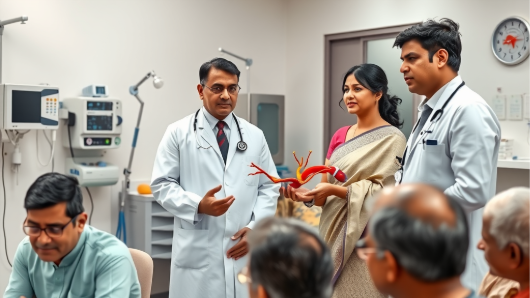Carotid stenting is a medical procedure that helps prevent strokes by opening blocked arteries in the neck.
This guide provides an overview of this procedure. It’s designed to be reader-friendly for those with limited background knowledge. We’ll cover what carotid stenting involves, its benefits, and possible risks.
Understanding Carotid Artery Disease and Its Implications
The carotid arteries are vital as they carry blood to your brain. When these arteries are blocked, it can lead to serious health issues, including strokes. Carotid artery disease is when these passages narrow, reducing blood flow to the brain.
- Definition and Importance: The carotid arteries are two major blood vessels in the neck that supply blood to the brain. Proper function is crucial for brain health.
- Diseases and Symptoms: When a blockage occurs, it can lead to carotid artery disease. Symptoms might include sudden numbness or weakness, particularly on one side of the body, trouble speaking, or a severe headache.
- Risk Factors: High blood pressure, smoking, diabetes, and high cholesterol are major risk factors.
Early detection is crucial for preventing strokes. Keeping track of these symptoms and risk factors can significantly impact your stroke prevention strategy.
Demystifying the Carotid Stenting Procedure
The carotid stenting procedure involves placing a small, expandable tube called a stent into the artery to prevent it from closing again.
- Step-by-step Process: During the carotid stenting procedure, a tiny balloon is first inserted and inflated to open the artery. The stent is then placed to keep it open.
- Stenting vs. Endarterectomy: Unlike endarterectomy, where a surgeon would remove the blockage surgically, stenting is less invasive, generally involving a quicker recovery.
- Who Is Suitable? It’s usually advised for those at high risk for endarterectomy due to age or other health factors.
The procedure can reduce the risk of stroke and generally involves a shorter recovery time than surgical options. It offers a great alternative for stroke prevention.
Benefits and Potential Risks of Carotid Stenting
Carotid stenting comes with both benefits and risks, much like any medical procedure.
Benefits:
- Improved blood flow to the brain
- Minimally invasive, meaning less time spent in the hospital
Potential Risks: These include the possibility of a stroke during or after the procedure, bleeding, or allergic reactions
It’s important to have thorough discussions with your doctor about whether this procedure is the right choice for you. Listening and asking questions are key steps in this process.
Life After Carotid Stenting: Recovery and Support
Recovery after a carotid stenting procedure involves a few simple steps and proper support.
Immediate Expectations: Most people can return home the next day. You’ll need to avoid heavy lifting and strenuous activity.
At-Home Care Tips:
- Take prescribed medications to prevent blood clots
- Follow a doctor’s advice on diet and activity
Caregiver Support: Loved ones play a big role by helping with daily tasks and providing emotional support.
Regular follow-ups with your doctor are essential to monitor progress. Following these guidelines ensures a smoother recovery.
Long-term Strategies for Cardiovascular Health
Maintaining heart health after carotid stenting involves lifestyle tweaks:
- Diet and Exercise: Eat heart-friendly foods like fruits and vegetables and engage in regular physical activity.
- Quit Smoking: Smoking worsens artery health.
- Manage Weight: Keeping a healthy weight reduces the risk of further artery issues.
These lifestyle changes work hand-in-hand with stenting to enhance your health, emphasizing that recovery and well-being are ongoing processes. Making these adjustments can help prevent future strokes and keep your heart healthy for years to come.
By understanding the carotid stenting procedure and subsequent lifestyle changes, individuals can make informed decisions on managing their health.
